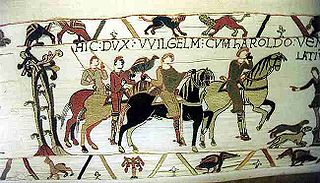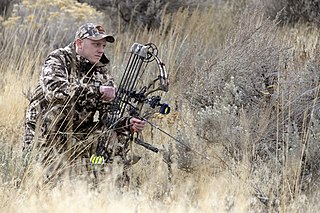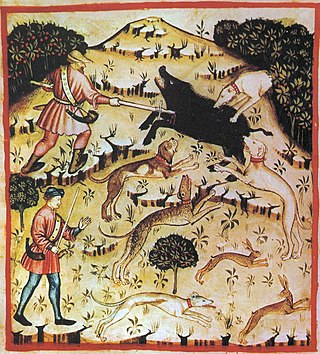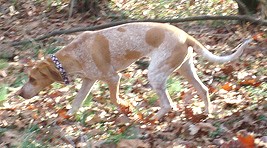
Treeing is a method of hunting where dogs are used to force animals that naturally climb up into trees, where they can be assessed or shot by hunters. The idiomatic phrase " Barking up the wrong tree " comes from this practice. [1]

Treeing is a method of hunting where dogs are used to force animals that naturally climb up into trees, where they can be assessed or shot by hunters. The idiomatic phrase " Barking up the wrong tree " comes from this practice. [1]
The treeing technique uses dogs to force naturally climbing animals into trees, where they can be assessed or shot by hunters. Treeing enables hunters to see the quarry and decide if the prey should be killed, and if so with a cleaner kill, or spared. [2] For example, females with youths may be left untouched, [2] or quarry may be observed or tagged for research.
Particularly used with coonhunting, treeing dogs are selected for the instinct to not cease barking at an animal after it has escaped into a tree. [3] This method of hunting is also used for cougar and black bear.
The dogs are trained to bay, not directly attack the quarry; however, it is not unheard of for the quarry to kill some of the dogs or for the dogs to kill the quarry. Usually, the quarry will climb a tree to escape the dogs after a period of chase and harassment. Blackmouth Cur use this method. Traditionally, the dogs were followed on foot by hunters listening to their barks, although some hunters now use radio direction finding equipment to follow the pack.
Treeing is also sometimes performed without the intention of killing the quarry for scientific purposes (such as radio-tagging) or recreational purposes. It is especially useful for cougars, which are notoriously stealthy and difficult to capture without the aid of dogs.
The examples and perspective in this section may not represent a worldwide view of the subject.(September 2019) |
Treeing is illegal in several US states, including California, [4] Montana, [5] New Mexico, [5] Oregon, [6] and Washington. [6]

The American black bear, also known as the black bear, is a species of medium-sized bear endemic to North America. It is the continent's smallest and most widely distributed bear species. The American black bear is an omnivore, with a diet varying greatly depending on season and location. It typically lives in largely forested areas, but will leave forests in search of food, and is sometimes attracted to human communities due to the immediate availability of food.

Fox hunting is a traditional activity involving the tracking, chase and, if caught, the killing of a fox, normally a red fox, by trained foxhounds or other scent hounds. A group of unarmed followers, led by a "master of foxhounds", follow the hounds on foot or on horseback.

A coonhound, colloquially a coon dog, is a type of scenthound, a member of the hound group. They are an American type of hunting dog developed for the hunting of raccoons and also for feral pigs, bobcats, cougars, and bears. There are six distinct breeds of coonhound.

Game or quarry is any wild animal hunted for animal products, for recreation ("sporting"), or for trophies. The species of animals hunted as game varies in different parts of the world and by different local jurisdictions, though most are terrestrial mammals and birds. Fish caught non-commercially are also referred to as game fish.

A feral pig is a domestic pig which has gone feral, meaning it lives in the wild. The term feral pig has also been applied to wild boars, which can interbreed with domestic pigs. They are found mostly in the Americas and Australia. Razorback and wild hog are Americanisms applied to feral pigs or boar–pig hybrids.

The Karelian Bear Dog is a Finnish breed of dog. In its home country, it is seen by many as a national treasure. Karelian Bear Dogs will hunt a variety of animals. Its quick reflexes and fearless nature have made it very popular for hunting large game including brown bears, moose, and wild boar. It was the breed's ability to hunt bears that earned the breed its name. The Karelian Bear Dog is among the top 10 most common dog breeds in Finland.
A canned hunt is a trophy hunt which is not "fair chase", typically by having game animals kept in a confined area such as in a fenced ranch to prevent the animals' escape and make tracking easier for the hunter, in order to increase the likelihood of the hunter obtaining a kill. The term has been used for driven grouse shooting, in which large areas of Britain are farmed for red grouse. According to WordNet, a canned hunt is a "hunt for animals that have been raised on game ranches until they are mature enough to be killed for trophy collections."

Royal hunting, also royal art of hunting, was a hunting practice of the aristocracy throughout the known world in the Middle Ages, from Europe to Far East. While humans hunted wild animals since time immemorial, and all classes engaged in hunting as an important source of food and at times the principal source of nutrition. The necessity of hunting was transformed into a stylized pastime of the aristocracy. More than a pastime, it was an important arena for social interaction, essential training for war, and a privilege and measurement of nobility. In Europe in the High Middle Ages the practice was widespread.

Bowhunting is the practice of hunting game animals by archery. Many indigenous peoples have employed the technique as their primary hunting method for thousands of years, and it has survived into contemporary use for sport and hunting.

Benji the Hunted is a 1987 American adventure drama film directed and written by Joe Camp and produced by Ben Vaughn. It is the fourth film in the Benji series. The film is about Benji trying to survive in the wilderness and looking after orphan cougar cubs after their mother is shot and killed by a hunter. It was released by Walt Disney Pictures. This was the last Benji movie to star Benjean, daughter of Higgins, in the title role.

The North American cougar is a cougar subspecies in North America. It is the biggest cat in North America. It was once common in eastern North America and is still prevalent in the western half of the continent. This subspecies includes populations in western Canada, the western United States, Florida, Mexico and Central America, and possibly South America northwest of the Andes Mountains. It thus includes the extirpated eastern cougar and extant Florida panther populations.

The West Siberian Laika or WSL, is a breed of spitz–type hunting dog. Russian publications indicate that the term West Siberian Laika loosely applied to hunting dogs originating with the Mansi and Khanty people in Ural and West Siberia, but there were no standards or registrations of WSL as such until 1930. Then WWII disrupted it for a while, but systematic breeding with registrations resumed after the war ended, in 1946. This was the time the breed began taking modern shape. Before that hunters only knew of Mansi Laika and Khanty Laika. In early 1960 many hunters in Ural still preferred the term Mansi Laika, when speaking of West Siberian Laika. In Russian language, the term Laika originated from the word layat that means to bark. The word Laika simply means barker. Any hunting Laika is a bark pointer. It is a versatile dog depending on use and environment, but in certain parts of the country they have become more specialized.

A working terrier is a small type of dog which pursues its quarry into the earth. According to the Oxford English Dictionary, the name dates back to at least 1440, and is derived from the French chien terrier 'digging dog', which is from Medieval Latin terrarius, ultimately from Latin terra (earth).

Tiger hunting is the capture and killing of tigers. Humans are the tigers' most significant predator, and illegal poaching is a major threat to the tigers. The Bengal tiger is the most common subspecies of tiger, constituting approximately 80% of the entire tiger population in Indian Sub-Continent, and is endemic to Bangladesh, Bhutan, Myanmar, Nepal, and India. Tigers have mythological, cultural and religious significance in these countries. Foreign invaders saw hunting of tigers as a symbol of masculinity and an adventurous sporting event. It has been hunted in these countries for centuries. In 1924, the tiger population in Asia was estimated to be more than 100,000. However, within less than a hundred years, it had declined to fewer than 3,200. Tiger has historically been a popular big game animal and has been hunted for prestige as well as for taking trophies. Extensive poaching has continued even after such hunting became illegal and legal protection was provided to the tiger. Now a conservation-reliant endangered species, the majority of the world's tigers live in captivity. Tigers were once considered to be harder to hunt than lions, due to their habit of living alone in dense cover and not noisily asserting their presence with roars as often.

Boar hunting is the practice of hunting wild boar, feral pigs, warthogs, and peccaries. Boar hunting was historically a dangerous exercise due to the tusked animal's ambush tactics as well as its thick hide and dense bones rendering them difficult to kill with premodern weapons.

Bear hunting is the act of hunting bears. Bear have been hunted since prehistoric times for their meat and fur. In addition to being a source of food, in modern times they have been favored by big game hunters due to their size and ferocity. Bear hunting has a vast history throughout Europe and North America, and hunting practices have varied based on location and type of bear.

The American English Coonhound, also referred to as the English Coonhound or the Redtick Coonhound, is a breed of coonhound that originated in and is typically bred in the Southern United States. It is descended from hunting hounds, especially foxhounds, brought to America by settlers during the 17th and 18th centuries. The breed's first recognition came from the United Kennel Club in 1905 as the English Fox and Coonhound. Further recognition has been granted in recent years by the American Kennel Club, first in the Foundation Stock Service and in 2011 as a fully recognized member of the hound group.
Romania has a long history of hunting and remains a remarkable hunting destination, drawing many hunters because of its large numbers of brown bears, wolves, wild boars, red deer, and chamois. The concentration of brown bears in the Carpathian Mountains of central Romania is largest in the world and contains half of all Europe's population, except Russia.

A bay dog is a dog that is specially trained to find, chase, and then bay, or howl, at a safe distance from large animals during a hunt, such as during a wild boar hunt.

Coon hunting is the practice of hunting raccoons, most often for their meat and fur. It is almost always done with specially bred dogs called coonhounds, of which there are six breeds, and is most commonly associated with rural life in the Southern United States. Coon hunting is also popular in the rural Midwest. Most coon hunts take place at night, with the dogs being turned loose, trailing and putting the raccoon up a tree without human assistance. Once the raccoon is in the tree, with the dog at the base, it is referred to as "treed", with "treeing" being the active verb form.